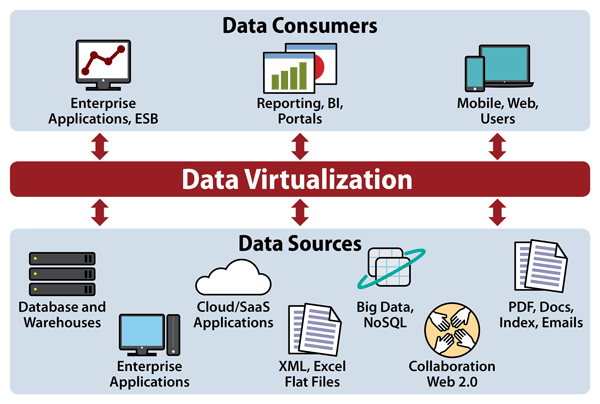Becoming data-driven today requires more resources, effort, and time than many businesses are willing to spare. It’s a tedious and lengthy process with many challenges that you can’t solve by simply buying new technologies and tools.
While you should invest in the latest data science and analytics technologies, you should also consider reorganizing your operations, as well as your management, responsibilities, roles, and business processes.
Becoming data-centric requires an all-encompassing business strategy with data science at its core. Building a data-driven business involves gathering data from every interaction between your company and potential prospects on the web. The data you gather can significantly improve your decision-making and enhance your business strategies.
However, that requires developing a highly flexible and scalable data architecture. With that in mind, here are the top data virtualization techniques for creating data architecture that will take your business to the next level.

-
Ad-hoc reporting
Things tend to move at a breakneck pace in the internet-driven business landscape. Companies of all sizes must make quick decisions due to a sudden threat, urgency, or opportunity. Those decisions can make or break their business organizations.
That’s why they must base their decisions on the most accurate and up-to-date data. Gathering such data requires access to multiple systems that companies can combine and use for analysis. To tap into such a system, you’ll need to invest in the latest data middleware.
What is middleware exactly?
Middleware can include transaction-processing monitors, web middleware tools, message-centered technologies, application servers, and database middleware. It’s a piece of technology that allows you to gather and manage data for distributed applications.
Database middleware helps a business develop a data-driven culture that provides multiple benefits, such as getting rid of internal data storage and moving to the cloud, making data easily accessible, and turning data into actionable business insights.
-
Data consistency
The data your business organization uses should be consistent, regardless of the individual consumer. The data consistency on your communication channels plays a crucial role in consumers’ perception of your brand.
If you want them to view you as trustworthy, authoritative, and customer-centric, all your data should be consistent and accurate. That includes your product or service data, sales data, company information, and so on.
-
360-degree responsiveness
Modern consumers are mostly mobile today. Whether they want to access your data via mobile devices or any other preferable device, you should ensure a full 360-degree view of all your relevant data regarding products, services, brands, business mission, etc.
You should also optimize the content on your website for all devices to make sure it is fully responsive and available to all consumers.
-
Data privacy rules
Data privacy rules are a critical aspect of a modern digital business. Every business should centralize data privacy rules rather than scatter them across multiple reports, databases, applications, and systems. Failing to comply with the latest data privacy regulations could expose you to many risks, ranging from ruined brand reputation to trouble with the law.
-
Zero-latency data
More data consumers are demanding low-latency data every day. Those aren’t only regular internet users requiring fast internet but also leading business organizations. They need fast networks that can process vast amounts of data in mere seconds for their data science and analysis purposes.
However, low-latency data requires a supportive and compatible data architecture that can work with data in real-time.
-
Innovative data processing technologies
There are incredibly robust data analytics and storage technologies available today that require little to no tech-savvy knowledge to implement and deploy. Aside from offering better security and data accessibility, they can also present enterprises with new business opportunities.
-
Access to master data
A new data architecture allows businesses to provide every consumer and data user with access to master data. Modern companies integrate master data in the data architecture for faster and easier access.
-
Access to descriptive data
Metadata plays a vital role in interpreting information that companies gather from the web. While managing and storing metadata can help a business, it also presents various challenges, such as making metadata readily available and understandable to consumers. The more transparent a company is, the more trustworthy it becomes in the eyes of the consumers.

Becoming data-driven
Each of these data virtualization techniques can help your business in various ways, but they’re not enough to make your organization entirely data-driven. However, each method provides a critical aspect that your organization needs to cover to become data-driven.
These techniques are the getaway to changing your ways and practices. They help you develop and deploy a better data architecture that allows you to gather information from all available sources on the web.
Conclusion
Data virtualization is essential to unlocking the full potential of data on the web. It allows businesses to use the information in their possession better and enable their consumers to use it more consistently.
The primary goal of becoming a data-driven business organization is to learn how to use data more effectively, efficiently, and widely to fully optimize and improve decision-making and other vital business processes.